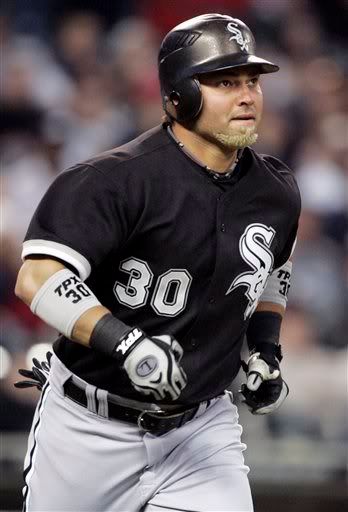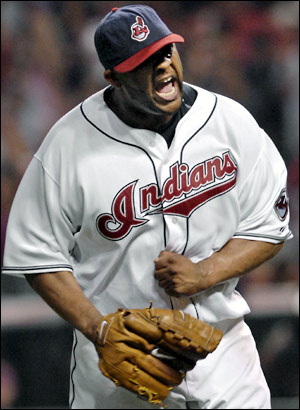Rob Neyer and Anthony McCarron have weighed in on the large-looming presence that is CC Sabathia, and the even larger one that will be his next contract, well north of the $100 million mark. Neyer followed that up with some comments on a Sports Illustrated article discussing Sabathia's size and other attributes as well.
I discussed CC a bit last week, but did not go into too much detail. Hopefully I'll remedy that oversight here.
Ben Reiter of SI thinks that CC's as good a bet as anyone to be a very good pitcher for the next several years, in spite of his size. McCarron things that this is a big risk, but one the Yankees have to take, and I mostly agree with that, though I don't necessarily think that comparing him only to other $100 million pitchers is fair, exactly. For one thing, the $100 million is just a convenient benchmark. If you brought it down to, say, $85 million, still a hell of a lot of money, you'd have the likes of Mike Mussina and Carlos Zambrano, neither of whom can be considered a bust, at least not yet.
And if you look at average annual value, the list gets even bigger. Andy Pettitte and Jake Peavy both made more money per year than Brown or Hampton, but then so did Roger Clemens and Jason Schmidt, and those didn't go so well. Roy Oswalt and Mark Buehrle and Roy Halladay aren't far off that mark, either, and their clubs are all pretty happy with them, but then there's also John Smoltz and Chris Carpenter, so...we just don't know. Spending money is a risk, and the more you spend, the bigger the risk. This is not news.
But among the few things we can say with confidence about CC Sabathia, there is this: He is not Barry Zito. Or Kevin Brown. Or Mike Hampton. Unfortunately, neither is he Johan Santana.
Still, for the sake of argument, it might be helpful to look at the warning signs associated with these other huge contracts, to see if they "should have known better", or something.
Rob Neyer had reasons that three of the previous four megadeals should have been avoided, but I find a few problems with his arguments:
"[Kevin] Brown had been up and down, durability-wise, and was well into his 30s
when the Dodgers signed him (and it should be said that he did pitch brilliantly
for two years)."
Granted, he was 35 when he signed, and should have been considered an injury risk for that reason alone, but "up and down"? He missed a month in 1995 with a dislocated finger, and missed some time in September of 1989 and 1990, but had been a veritable workhorse every year from 1991 to 1998, averaging well over 200 innings per 162 games.
The Dodgers got three very good (if non-consecutive) years and two injury-plagued ones from Brown, and then they traded him for two good years of Jeff Weaver (his last two good ones, it would turn out) plus two other pitchers. That's about as good as they could have hoped, given the fact that they were dumb enough to sign a 35-year old pitcher through his 40th birthday.
Another one of Neyer's retrospective assessments:
"Zito was a disaster waiting to happen, his performance obviously slipping long before the Giants signed him. "
Have to disagree there, too, to some degree. There may have been some advanced metrics to suggest the impending drop in performance, but his slipping performance was hardly "obvious". At the time of the signing, Zito was a 28-year old lefty who had averaged 16 wins, 220 innings and a much better than average ERA for the previous 6 years. Those aren't the only important numbers, naturally, but you can hardly make a case for an obvious drop in skills.
Even if you just looked at the previous 2-3 years, he was still a durable, better than average lefty starter, which is a rare commodity. Of course, $18 million a year is too much to pay for that commodity, but there was little reason to think that Zito would turn out to be as bad as he's been the last two seasons.
"And Hampton was a very good pitcher who was thrown into an extreme environment."
Not sure about this one either. If anything, he was a so-so pitcher who had thrived in one extreme environment, and was therefore highly overrated. Hampton had been helped significantly by the severe pitchers' parks in Houston when he was with the Astros and in New York. His career ERA split after the 2000 season was 2.88/4.09, in over 1,200 innings of total work, meaning that away from those pitchers' havens, he was basically a little better than average.
Not only was he removed from that extreme environment, but he was forced to pitch half his games in an even more extreme environment, one with the exact opposite properties of those that had masked his mediocrity. That revealed his weaknesses, and severely so. Colorado to their credit, unloaded him after two seasons, and got some value in return.
Sabathia is none of these things. Unlike Brown, he's not almost 35. Unlike Hampton, his success does not come from the parks he's called home. Unlike Zito, he doesn't have rising walk rates and dropping strikeout rates and his best season was last year, not five seasons ago.
He doesn't have control problems. He doesn't have obviously problematic mechanics. He doesn't just "get by" with a decent fastball and a whole lot of junk. By all accounts, he's not a self-absorbed jerk, or a hot-head, or a primadonna, or a clubhouse cancer, or anything of that ilk. He doesn't appear to wilt in the heat of a pennant race or the playoffs. In short, there's really nothing wrong with him, except...
His size. Unlike Neyer's assessment, though, this is not the elephant in the room nobody talks about. For one thing, everybody's talking about it, and for another, can't we come up with a less loaded analogy than that for a fat guy? "Sabathia's weight is the gauche, pink drapes in the room everyone's ignoring!" Nah, now we're upsetting a different demographic. Sorry, fat guys.
He's listed at 6'7", 290 lbs, which means he's probably well over 300 lbs these days. There's never been any pitcher his size who's been successful for any length of time. Heck, there's really never been anybody his size in MLB. A mediocre relief pitcher named Jumbo Brown, who pitched before World War II, was listed at 295 lbs, but he was gone after his age 34 season, perhaps to fight the war, and never even pitched more than 90 innings in a year.
A handful of other pitchers are listed as being over 250, but most of them (Jeff Juden, Jeff Nelson, Chris Young, maybe Tim Stoddard) are very tall and a different body type from CC. Others, like Dennys Reyes and Bartolo Colon, are much shorter and fatter, whereas CC is more thick than fat.
And the ones who might be comparable physically, like Bobby Jenks or Chris Britton, don't have the same workload put on them because they pitch only in relief. There's a big difference between throwing 800 pitches a year and 3,500, and we have no idea how Sabathia's knees (and back, and arm...) will hold up under that strain. Either that or they don't have enough of a MLB track record to say anything about them, like Colter Bean or Humberto Sanchez. There just isn't a reasonable comparison for CC anywhere.
And because of this, the others in the exclusive $100M club, Mike Hampton, Kevin Brown, Barry Zito and Johan Santana, are almost nothing like Sabathia, except perhaps that three of the four are lefties. The pitching styles, and perhaps most important, body types, are very different from CC's. This is what makes it so difficult to project Sabathia's performance going forward.
Baseball Prospectus, an organization that makes a living at telling you what baseball players are likely to do, says that CC's "Similarity Index" (incorporating body type and performance) is 5, where anything less than 20 is "historically unusual". That "5" means basically that they don't have any idea at all.
For comparison, coming into 2008, Andy Pettitte was a 41, Roy Halladay a 43, Matt Morris a 56, Cole Hamels a 48. Those guys were reasonably common, and more or less performed as you might have expected them to perform. (Much better than that, in Halladay's case.)
Jamie Moyer and Kenny Rogers were both in single digits, like CC, and while Rogers basically pitched as badly as BP expected, Moyer was much, much better than anticipated, and nobody exactly knows why. Randy Johnson's Similarity Index is a zero, meaning that there's really nobody even remotely like him for comparison's sake, and CC's not much better so take anything you see about what he might do with a grain or two of salt.




























